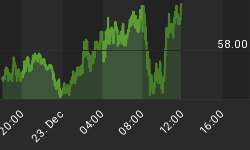Written on Jan 21 for members.
Jack Be Nimble, Jack Be Quick
Jack Jump Over the Candlestick
In An Inverted Risk/Reward Ratio our bottom line was:
We think 2008 will offer a buy and hold investors a similar inverted risk/reward profile as the market returned in 2007. We see best case, average returns with above average risk. Despite what many Wall Street analysts are forecasting in higher P/E multiples, we are looking for multiples to contract as volatility and risk premiums remain elevated throughout next year and beyond. That said, for the disciplined and nimble trader this environment could be ideal.
Friday's close on SPX took put us down 10% for the year and 16% from the October 2007 top. The main culprit driving this volatility, the S&P financial sector, has seen total market capitalization fall below $2t for the first time since late 2003. In just 8 months the financials have lost nearly $1t in market cap, a number that represents over 7% of entire US GDP. By any measure a 30% haircut in the largest S&P sector represents a substantial correction, discounting many worse case scenario estimates for losses attributed to the credit bubble bursting. We think the credit melt down has further to go and thus financials are not out of the woods. That said, clearly the market has discounted a substantial amount of that risk.
At 1325 on SPX, we are essentially back at the same level traded in March 1999 when we were rallying out of the LTCM hole and just 12 months from the 2000 tech bubble high. The LTCM implosion was the last major credit event we experienced which also saw LIBOR spreads blowing out to extreme levels. During the LTCM debacle 3M LIBOR - 3M T-Bill spread shot from 75bps to 175bp but came back down within months. With the LIBOR spread easing and the credit market stabilizing, SPX bottomed in October 1998 near 925, representing a 22% pullback from the July 1998 high of 1190. From that low, the SPX rallied 50% cresting at 1420 in mid-1999, before pulling back 10% prior to the last run into the 2000 high rallying another 25% to 1552. Similarly, this year the same LIBOR spread has narrowed 125bps from its peak of 225bps. We have also seen a credit market correction in the SPX from the October 2007 top that equals the LTCM correction in price at 1307. We aren't suggesting the declines are over or that we are in store for a 50% rally, but the inter-bank market is normalizing and the stock correction is near extreme levels and is starting to look cheap.

With the 10YR yield near its lows trading at 3.65% and equity yields near their highs, the equity risk premium has spiked by 250bps since last year's lows in July. Other spikes in risk premium corresponded with lows in 2007, 2005, 2004, 2003, 2002 (spiking 400bps!), 2001 and in 1998 during LTCM. Risk premiums have been widening ever since last summer (the 10YR hit 5.25% and the SPX hit the old 2000 high) when the credit markets seized up and of course can continue to widen as witnessed in 2002. We believe with LIBOR spreads normalizing, demonstrating some freeing up of risk capital, these discounts represent compelling relative value for equity managers and could start to attract money back into stocks.

The disciplined and nimble trader should realize that the same math that showed an inverted risk/reward at the beginning of the year is now narrowed with the subsequent decline. Whereas just weeks ago you were risking say 15% to make 7.5%, you are now risking 5% to make 17.5%. These risk/reward ratios aren't written in any rule book, they are just estimates based on discount rates of return and perceived downside risk. But it highlights the extreme volatility we anticipated and reinforces the idea of staying in front of the crowd rather than ride with them. If we were just short or just long at the end of the day we will best case be breaking even. Traders, who don't marry positions and stay unbiased, objectively letting the market provide discounted risk/reward rather than pundits and analysts, will thrive in this volatile environment.
We aren't suggesting anyone without the balance sheet of the likes of BRK (which is up 18% since the credit market seized up) step in front of the selling to catch a falling knife. Nor are we suggesting prices are about to vault higher like it's 1999. However the stock market is cheap on a number of metrics and represents attractive relative value. Upon some stabilization in prices those able to pull the trigger on the long side potentially could be well rewarded.
















